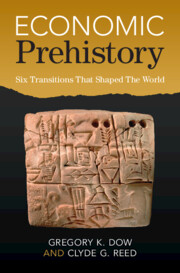Book contents
- Economic Prehistory
- Economic Prehistory
- Copyright page
- Dedication
- Contents
- Figures
- Tables
- Preface
- Acknowledgments
- Abbreviations
- Part I Prologue
- Part II Sedentism and Agriculture
- Part III Inequality and Warfare
- 6 The Transition to Inequality
- 7 Warfare between Egalitarian Groups
- 8 Warfare between Elite Groups
- Part IV Cities and States
- Part V Epilogue
- References
- Author Index (Abridged)
- Subject Index
8 - Warfare between Elite Groups
from Part III - Inequality and Warfare
Published online by Cambridge University Press: 10 February 2023
- Economic Prehistory
- Economic Prehistory
- Copyright page
- Dedication
- Contents
- Figures
- Tables
- Preface
- Acknowledgments
- Abbreviations
- Part I Prologue
- Part II Sedentism and Agriculture
- Part III Inequality and Warfare
- 6 The Transition to Inequality
- 7 Warfare between Egalitarian Groups
- 8 Warfare between Elite Groups
- Part IV Cities and States
- Part V Epilogue
- References
- Author Index (Abridged)
- Subject Index
Summary
A large body of archaeological and anthropological research suggests that warfare is more common when societies are stratified. This is true for societies based on either sedentary foraging or agriculture. We argue that warfare in stratified societies does not require climatic or technological shocks, and results from competition among rival elites over land rent. In our model, elites recruit specialized warriors by offering booty in the event of victory, which may involve elevation to elite status. After each elite recruits an army, the rival elites must decide whether to attack, defend, or flee. We solve for the equilibrium at the combat stage as a function of army sizes, and use backward induction to solve for the equilibrium army sizes. If stratification is relatively low (the land rents are small relative to commoner food income), elites can sometimes win through intimidation without fighting an actual war. But if stratification is high, such equilibria disappear and the only outcome is a mixed-strategy equilbrium with a positive probability of open war. In either case, successful elites expand their territory. Fiscal constraints on the capacity of elites to recruit warriors can sometimes limit warfare, but do not prevent it entirely.
Keywords
- Type
- Chapter
- Information
- Economic PrehistorySix Transitions That Shaped The World, pp. 306 - 356Publisher: Cambridge University PressPrint publication year: 2023



